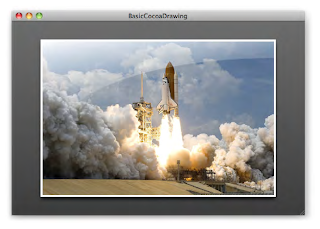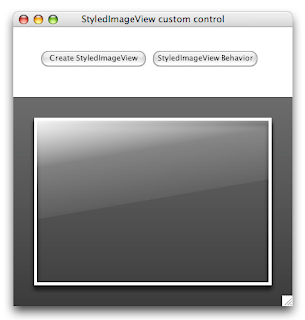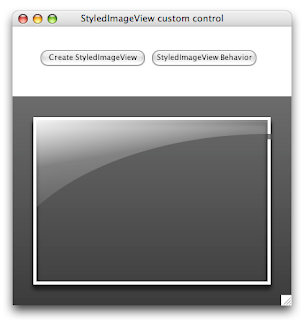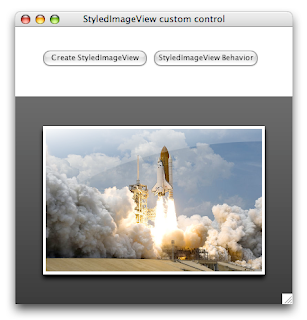
How far did we get last time?
- A background gradient behind the image
- An image with a 4px white border
- A drop shadow below the image
And our custom control group has a behavior button script to handle resizing and toggling the display of the drop shadow. Now we come to the tricky part:
- A sheen over the image
Perhaps it's best to explain what a 'sheen' is: a visual effect that displays a glossy white overlay, clipped to a bezier curve, rendering the illusion of a light source in the upper-left corner of the image. Cute, but how does one implement it? Scott used a linear gradient (tilted slightly to enhance the illusion) to fill a path determined by the edges of the image and a bezier path. As LiveCode doesn't have bezier curves on offer, it was time to think a bit differently.
Let's start with the gradient. Linear gradients are not too difficult to implement; but we have to give it the right angle. Trigonometry has never been my best subject, but I remembered anough to figure out how to rotate the gradient by 10 degrees. And the LiveCode documentation came with example code for converting degrees to radians.
Here's an update for the "Create" button:
on mouseUp
local tGroup
CreateCustomControlGroup "StyledImageView", tGroup
CreateBackgroundGraphic tGroup
CreateViewImage tGroup
CreateSheen tGroup
set the behavior of tGroup to the long id of button "StyledImageView Behavior"
set the showShadow of tGroup to true
end mouseUp
private command CreateCustomControlGroup pGroupName, @rGroupId
-- same as before, omitting for brevity
end CreateCustomControlGroup
private command CreateBackgroundGraphic pGroup
-- same as before, omitting for brevity
end CreateBackgroundGraphic
private command CreateViewImage pGroup
-- same as before, omitting for brevity
end CreateViewImage
private command CreateSheen pGroup
CreateSheenGradient pGroup
end CreateSheen
private command CreateSheenGradient pGroup
reset the templateGraphic
set the style of the templateGraphic to "Rectangle"
set the rectangle of the templateGraphic to 30,130,370,310
set the lineSize of the templateGraphic to 0
set the opaque of the templateGraphic to true
set the fillGradient["type"] of the templateGraphic to "linear"
set the fillGradient["from"] of the templateGraphic to 30,130
set the fillGradient["to"] of the templateGraphic to 61,307
set the fillGradient["via"] of the templateGraphic to 207,99
set the fillGradient["ramp"] of the templateGraphic to \
"0.00000,255,255,255" & return & \
"0.40000,255,255,255,51" & return & \
"0.79999,255,255,255,13" & return & \
"0.80000,255,255,255,0" & return & \
"1.00000,255,255,255,0"
create graphic "GradientGraphic" in pGroup
reset the templateGraphic
end CreateSheenGradient
Delete the existing custom control group and hit the button again. You should see the gradient graphic on top of the image control.

We'll also have to update the resizing logic in our behavior script, but I'll leave that for later. Our next challenge is the bezier curve, and how we can construct a path to clip the gradient to it. And then it struck me: we can achieve the same effect (in this case) by creating an oval graphic and then clip that out of the gradient graphic.
Inspiration came from an old blog post by RunRev's Mark Waddingham. The original blog is no onger on the web, but thanks to the Wayback Machine internet archive, I was able to dig up this snapshot. Here's the gist: you take two control, comlbine them into a group, and then use different blend modes for the group and graphics to achieve soft clipping.
The only difference: Mark talks about clipping something down to a graphic shape, whereas I wanted to clip a graphic shape out of the original shape. But as it turns out to, this was as easy as picking a different blend mode for the clipping graphic. So let's use this knowledge to once more update the "Create" button:
on mouseUp
local tGroup
CreateCustomControlGroup "StyledImageView", tGroup
CreateBackgroundGraphic tGroup
CreateViewImage tGroup
CreateSheen tGroup
set the behavior of tGroup to the long id of button "StyledImageView Behavior"
set the showShadow of tGroup to true
end mouseUp
private command CreateCustomControlGroup pGroupName, @rGroupId
-- same as before, omitting for brevity
end CreateCustomControlGroup
private command CreateBackgroundGraphic pGroup
-- same as before, omitting for brevity
end CreateBackgroundGraphic
private command CreateViewImage pGroup
-- same as before, omitting for brevity
end CreateViewImage
private command CreateSheen pGroup
local tSheenGroup
reset the templateGroup
set the rectangle of the templateGroup to 30,130,370,310
set the lockLocation of the templateGroup to true
set the margins of the templateGroup to 0
set the ink of the templateGroup to "blendSrcOver"
create group "SheenGroup" in pGroup
put it into tSheenGroup
reset the templateGroup
CreateSheenGradient tSheenGroup
CreateSheenClipping tSheenGroup
end CreateSheen
private command CreateSheenGradient pGroup
-- same as before, omitting for brevity
end CreateSheenGradient
private command CreateSheenClipping pGroup
reset the templateGraphic
set the style of the templateGraphic to "Oval"
set the rectangle of the templateGraphic to 10,10,10,10
set the ink of the templateGraphic to "blendDstOut"
set the lineSize of the templateGraphic to 0
set the opaque of the templateGraphic to true
create graphic "ClippingGraphic" in pGroup
set the rectangle of it to -21,154,761,586
reset the templateGraphic
end CreateSheenClipping
Delete the existing custom control group and hit the button again.

Getting there - now we just need to extend the behavior script with the logic to properly resize these new parts:
## engine message handlers
on mouseDoubleUp
-- same as before, omitting for brevity
end mouseDoubleUp
on resizeControl
-- same as before, omitting for brevity
end resizeControl
## property setters and getters
setProp showShadow pShowShadowBoolean
-- same as before, omitting for brevity
end showShadow
setProp showSheen pShowSheenBoolean
set the visible of group "SheenGroup" of me to pShowSheenBoolean
end showSheen
getProp showSheen
return the visible of group "SheenGroup" of me
end showSheen
setProp imageFileName pFileName
-- same as before, omitting for brevity
end imageFileName
getProp imageFileName
-- same as before, omitting for brevity
end imageFileName
## private commands and functions
private command SIV_ReshapeControl
local tImageRectangle
SIV_DetermineImageRectangle tImageRectangle
SIV_ReshapeBackground
SIV_ReshapeImage tImageRectangle
SIV_ReshapeSheen tImageRectangle
end SIV_ReshapeControl
private command SIV_DetermineImageRectangle @rImageRectangle
-- same as before, omitting for brevity
end SIV_DetermineImageRectangle
private command SIV_ReshapeBackground
-- same as before, omitting for brevity
end SIV_ReshapeBackground
private command SIV_ReshapeImage pImageRectangle
-- same as before, omitting for brevity
end SIV_ReshapeImage
private command SIV_ReshapeSheen pImageRectangle
set the rectangle of group "SheenGroup" of me to pImageRectangle
local tImageWidth, tImageHeight
put (item 3 of pImageRectangle) - (item 1 of pImageRectangle) into tImageWidth
put (item 4 of pImageRectangle) - (item 2 of pImageRectangle) into tImageHeight
--> reshape the gradient rect
local tGradientRectangle, tGradientHeight, tFromPoint, tToPoint, tViaPoint
put pImageRectangle into tGradientRectangle
put trunc(tImageHeight * 0.75) into tGradientHeight
put ((item 2 of tGradientRectangle) + tGradientHeight) into item 4 of tGradientRectangle
put (item 1 of tGradientRectangle), \
(item 2 of tGradientRectangle) \
into tFromPoint
put ((item 1 of tGradientRectangle) + trunc(SIV_SinInDegrees(10) * tGradientHeight)), \
((item 2 of tGradientRectangle) + trunc(SIV_CosInDegrees(10) * tGradientHeight)) \
into tToPoint
put ((item 1 of tGradientRectangle) + trunc(SIV_SinInDegrees(80) * tGradientHeight)), \
((item 2 of tGradientRectangle) - trunc(SIV_CosInDegrees(80) * tGradientHeight)) \
into tViaPoint
set the rectangle of graphic "GradientGraphic" of group "SheenGroup" of me to tGradientRectangle
set the fillGradient["from"] of graphic "GradientGraphic" of group "SheenGroup" of me to tFromPoint
set the fillGradient["to"] of graphic "GradientGraphic" of group "SheenGroup" of me to tToPoint
set the fillGradient["via"] of graphic "GradientGraphic" of group "SheenGroup" of me to tViaPoint
--> reshape the clipping oval
local tClippingRectangle, tXRadius, tYRadius
put trunc(tImageWidth * 1.15) into tXRadius
put trunc(tImageHeight * 0.9) into tYRadius
put ((item 3 of pImageRectangle) - tXRadius), \
((item 4 of pImageRectangle) - tYRadius), \
((item 3 of pImageRectangle) + tXRadius), \
((item 4 of pImageRectangle) + tYRadius) \
into tClippingRectangle
set the rectangle of graphic "ClippingGraphic" of group "SheenGroup" of me to tClippingRectangle
end SIV_ReshapeSheen
private function SIV_SinInDegrees angleInDegrees
return sin(angleInDegrees * pi / 180)
end SIV_SinInDegrees
private function SIV_CosInDegrees angleInDegrees
return cos(angleInDegrees * pi / 180)
end SIV_CosInDegrees
Delete the existing custom control group and hit the "Create" button again. Then double-click to select an image. I downloaded and selected the original image that Scott used - a public domain image from NASA.

I would say that this looks like the original StyledImageViewClass. Next time, we'll take this custom control a bit further, by turning it into a DropTool. Stay tuned...
No comments:
Post a Comment